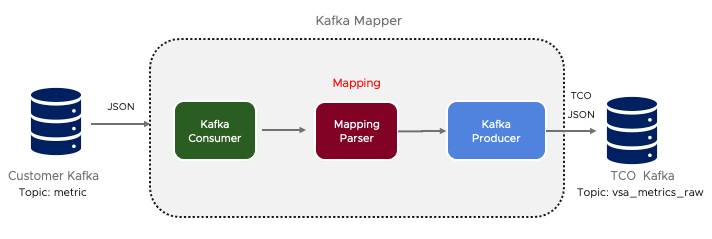Kafka Mapper is one more option available in VMware Telco Cloud Operations that helps you to bring data into the system for further analysis.
It connects to the source Kafka broker and tap data from a given topic, extract and transform data into the VMware Telco Cloud Operations object model, and then store it in VMware Telco Cloud Operations.

- Consuming JSON data from the customer Kafka topic.
- Converting data to VMware Telco Cloud Operations object model.
- Processing data based on user-defined mapping to VMware Telco Cloud Operations-defined JSON format.
- Performing validation and send processed records to the internal VMware Telco Cloud Operations Kafka for further consumption (for example: reporting, KPI calculation).
Mapping
In order to comply with VMware Telco Cloud Operations data model, you must inform a mapping that will be used to process incoming records. Properties can be mapped using JSON Path expressions.
Operators
| Operators | Description |
|---|---|
| == | left is equal to right (note that 1 is not equal to '1') |
| != | left is not equal to right |
| < | left is less than right |
| <= | left is less or equal to right |
| > | left is greater than right |
| >= | left is greater than or equal to right |
| =~ | left matches regular expression [?(@.name =~ /foo.*?/i)] |
| in | left exists in right [?(@.size in ['S', 'M'])] |
| nin | left does not exists in right |
| subsetof | left is a subset of right [?(@.sizes subsetof ['S', 'M', 'L'])] |
| anyof | left has an intersection with right [?(@.sizes anyof ['M', 'L'])] |
| noneof | left has no intersection with right [?(@.sizes noneof ['M', 'L'])] |
| size | size of left (array or string) should match right |
| empty | left (array or string) should be empty |
{
"network":{
"type":"ipv6",
"direction":"inbound-XYZ",
"iana_number":41
},
"error":{
"code":"process has exited. inode=0, tcp_state=TIME-WAIT"
},
"user":{
"name":"root",
"full_name":"root",
"id":"0"
},
"destination":{
"ip":"127.0.0.1",
"port":2282
},
"service":{
"type":"system"
},
"event":{
"duration":17345372,
"dataset":"system.socket",
"module":"system"
},
"tags":[
"beats_input_raw_event"
],
"ecs":{
"version":"1.6.0"
},
"host":{
"architecture":"x86_64",
"os":{
"name":"Red Hat Enterprise Linux Server",
"family":"redhat",
"platform":"rhel",
"version":"7.9 (Maipo)",
"codename":"Maipo",
"kernel":"3.10.0-1160.6.1.el7.x86_64"
},
"containerized":false,
"name":"vl-vm-ic762",
"id":"d69e0181566b99b60326991cad162e19",
"ip":[
"10.247.152.27",
"fe80::f816:3eff:fe63:615f"
],
"mac":[
"fa:16:3e:63:61:5f"
],
"hostname":"vl-vm-ic762"
},
"@timestamp":"2021-02-10T00:02:42.705Z",
"source":{
"ip":"127.0.0.1",
"port":34086
},
"metricset":{
"period":300000,
"name":"socket"
},
"agent":{
"name":"vl-vm-ic762",
"type":"metricbeat",
"ephemeral_id":"64506ba5-3ea9-4a76-a0d9-7b1d369cc807",
"id":"705840f2-3674-4c2e-9a70-081042d34ee1",
"version":"7.10.0",
"hostname":"vl-vm-ic762"
},
"@version":"1",
"system":{
"socket":{
"remote":{
"ip":"127.0.0.1",
"port":34086
},
"local":{
"ip":"127.0.0.1",
"port":2282
}
}
}
}
Expressions
- Contains:
$.network[?(@.type =~ /^.*ip.*$/i)]
The expression looks for the element "type" under "network" that contains the "
ip" string. - Match on prefix:
$.network[?(@.direction =~ /^.*inbound-.*$/i)
The expression looks for the element "direction" under "network" that contains the prefix "
inbound-" string. - Match on suffix:
$.network[?(@.direction =~ /^.*-outbound.*$/i)
The expression looks for the element "direction" under "network" that contains the suffix "
-outbound" string. - Match on numeric value:
$.network[?(@.iana_number > 10 )
The expression looks for the element "iana_number" under "network" that contains values greater than "10".
- Match on string value:
$.network[?(@.type == 'ipv6')
The expression looks for the element "type" under "network" that contains exactly the "ipv6" string.
- Match on value and suffix regex:
$.network[?(@.iana_number < 10 || @.direction =~ /^.*-outbound.*$/i)
The expression looks for the element "iana_number" smaller than "10" and for the element "direction" that contains the suffix "
-outbound" string, both under "network".